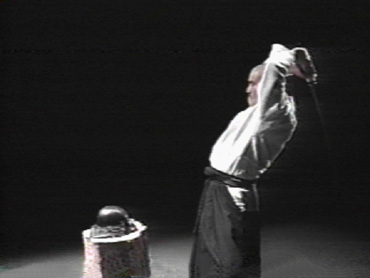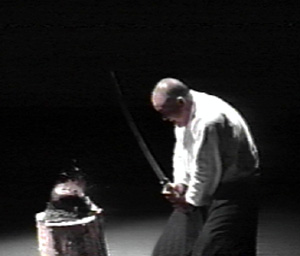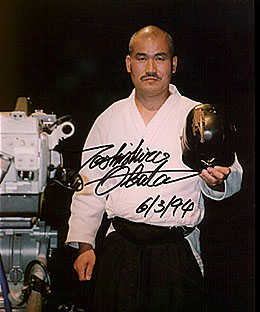

Kabutowari – Helmet-Splitting

On February 16, 1994, master swordsman and Shinkendo founder Obata Toshishiro-kaiso performed a rare, record-setting kabutowari (helmet-splitting) test using a sword created in the traditional Japanese fashion by American swordsmith Paul Champagne. The sword was only lightly polished, and was unmounted save for a length of nylon rope tied around the tang. The helmet was an authentic Hineno-style kabuto, dating back between 1573-1602. Rather than requiring elaborate preparations like previous testers, Obata-kaiso preferred to lay the helmet loosely on a tree stump to simulate a more realistic atmosphere. After the test, resulting in a 13-centimeter (4 sun, 3 bu) gash in the kabuto, the katana blade remained undamaged.
Footage of this kabutowari performance is recorded on the video Shinkendo: Samurai Swordsmanship. More information about Obata-kaiso's test and about sword-testing in general is documented in the book Shinkendo Tameshigiri: Samurai Swordsmanship & Test-Cutting.
The following article appeared in the April edition of The International Shinkendo Federation Newsletter (Volume 1, Issue 2 1995).
 Ever since the use of weapons against armor began, both swordsmith and armor-maker have sought to surpass each other's work. The swordsmith's goal was to forge a blade that was sharp
enough to penetrate armor, but still strong enough to be unbreakable, and light enough to be wielded effectively.
The armor-maker's goal was to design armor that could not be pierced by any weapon, yet would be light and flexible enough to allow the wearer maximum mobility and speed in battle. The samurai hoped to procure the best of both – hence the practice of test-cutting
held great importance. Of special value historically was the performance of kabutowari, helmet-splitting tests, since not only could a helmet cause more damage to a blade, but the attempt was inevitably more dangerous to the tester.
Ever since the use of weapons against armor began, both swordsmith and armor-maker have sought to surpass each other's work. The swordsmith's goal was to forge a blade that was sharp
enough to penetrate armor, but still strong enough to be unbreakable, and light enough to be wielded effectively.
The armor-maker's goal was to design armor that could not be pierced by any weapon, yet would be light and flexible enough to allow the wearer maximum mobility and speed in battle. The samurai hoped to procure the best of both – hence the practice of test-cutting
held great importance. Of special value historically was the performance of kabutowari, helmet-splitting tests, since not only could a helmet cause more damage to a blade, but the attempt was inevitably more dangerous to the tester.
 During the Kamakura Era, there were many famous swordsmiths (such as Masamune, Muramasa, and Sadamune) producing excellent blades. As a result, stories and legends arose regarding a nihonto's ability to cut through not only stone, but demons as well!
In the late 1500s, in the mountains of Bitchu Province (Okayama Prefecture), it had been rumored that there was a demon lurking who took the form of a grinning woman carrying a child. Late one night, Nakajima Kuridayu was startled by the appearance of this demon.
Instinctively, he drew his sword and instantly swung at the phantom, beheading it, at which the demon disappeared. The next day, Nakajima returned to view the scene in the daylight – and found two stone statues without their heads! The phantom never appeared again,
and the sword that had cut through stone was thereafter named Nikkari Aoe, the "Grinning Aoe" blade.
During the Kamakura Era, there were many famous swordsmiths (such as Masamune, Muramasa, and Sadamune) producing excellent blades. As a result, stories and legends arose regarding a nihonto's ability to cut through not only stone, but demons as well!
In the late 1500s, in the mountains of Bitchu Province (Okayama Prefecture), it had been rumored that there was a demon lurking who took the form of a grinning woman carrying a child. Late one night, Nakajima Kuridayu was startled by the appearance of this demon.
Instinctively, he drew his sword and instantly swung at the phantom, beheading it, at which the demon disappeared. The next day, Nakajima returned to view the scene in the daylight – and found two stone statues without their heads! The phantom never appeared again,
and the sword that had cut through stone was thereafter named Nikkari Aoe, the "Grinning Aoe" blade.
Kotetsu Okisato and Yamada Asaemon
During the early Shinto period (early 1600s), a famous armor-maker by the name of Kotetsu Okisato had become known especially for his solid helmets. However, at the age of 50 he decided that he would rather make swords to cut with than helmets to be cut. At this he also excelled, inspiring praise from Yamada Asaemon, public executioner and professional sword-tester for Kotetsu, who declared his Kotetsu blade was one of the sharpest he had ever used. At that time, the blades of another swordsmith, Kanefusa, were also valued highly for their sharpness.
Toward the end of the Edo Era (early 1800s), a swordsmith named Yamaura Minamoto no Kiyomaro, considered a genius of his time, developed strong, sharp, yet beautiful blades. It is said that, suffering a stroke at the age of 42, he realized that he would never be able to make good swords again, and committed suicide. Kiyomaro's older brother, Saneo, was also his senior student, and Saneo's swords have left the most records for test-cutting on hard materials such as helmets, sword guards, antlers, and wrought iron.
 Various stories and records of helmet-splitting tests date from the Genji
and Heike periods of the 12th century Gempei Era and onward to the present. In 1336,
Ashikaga Takauji, after having once been defeated, decided that he must obtain a
much better sword. To determine the sword's value, he ordered two suits of armor
and a helmet to be made specifically for testing the blade. The suits of armor, placed
upright with one inside the other, were topped with the helmet in order to
effect a realistic test. The test was performed using a blade made by the swordsmith Kanemitsu.
Ashikaga Takauji was so pleased with the outcome that he then took Kanemitsu on
to Kyushu with him. Later, Ashikaga, together with Yoshisada Nitta, went on to
oust the Kamakura government. Ashikaga Takauji eventually became shogun.
Various stories and records of helmet-splitting tests date from the Genji
and Heike periods of the 12th century Gempei Era and onward to the present. In 1336,
Ashikaga Takauji, after having once been defeated, decided that he must obtain a
much better sword. To determine the sword's value, he ordered two suits of armor
and a helmet to be made specifically for testing the blade. The suits of armor, placed
upright with one inside the other, were topped with the helmet in order to
effect a realistic test. The test was performed using a blade made by the swordsmith Kanemitsu.
Ashikaga Takauji was so pleased with the outcome that he then took Kanemitsu on
to Kyushu with him. Later, Ashikaga, together with Yoshisada Nitta, went on to
oust the Kamakura government. Ashikaga Takauji eventually became shogun.
In the early 1600s, a certain sword-tester by the name of Ito Banzaemon had ordered several swords from swordsmith Hokinokami Nobutaka. Upon testing the blades on helmets, however, he found that none were able to make a cut. Ito Banzaemon, in fury and frustration, fumed at the smith, "Either make a sword that can split the helmet... or commit suicide!" The swordsmith then laid a sheet of wet rice paper over the helmet and had Ito Banzaemon try again. This time, the blade cut through, failing to glance off as it had before.
In 1853, an exhaustive sword-breaking test was conducted at Shinshu Matsushiro-han in Nagano prefecture under the rule of the Sanada family. The test was performed in the presence of three observers and four Ometsuke (official examiners). In this test, seven swordsmen were involved in the breaking of 12 swords to determine the strongest. It was the sword made by Yamaura Minamoto-no-Saneo that emerged champion. Of the 12 sequential articles against which the blades were tested, the seventh was a helmet owned by Kahei. In this case, no gash was made in the helmet – rather the sword itself was bent by the blow.
A sword made by Izumi-no-kami Kanesada bore an inscription next to the signature which indicated the blade's success in helmet-splitting. The blade, a 52.9-centimeter wakizashi, was owned by Saigo Takamori, one of the three famous revolutionaries of the 1800s responsible for transforming the Edo government into the Meiji government. Another blade from the same period bears a similar inscription, "kabutowari", next to the signature. This blade was made by Izumi-no-kami Tadashige and was owned by the famous professional assassin Tanaka Shinbei.
Please direct questions and comments to:
![]()










